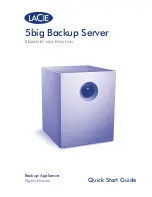
Disassembly and Reassembly 4-47
Hot-Swapping a Hard Drive
If you are swapping out a faulty hard drive, you can determine which drive to
remove by checking its Disk Drive Status LEDs. See “Status LED Indicator
Descriptions” in Chapter 1.
Note:
When the Disk Error LED indicates a drive fault
(steady amber light), you can remove the drive and swap in
a replacement at any time without needing to power down
the system. Drive manufacturer's caution against moving a
drive that is still spinning because of possible damage to the
drive. Also, when the Disk Error LED indicates that the hard
disk drive is being rebuilt (flashing amber light) do not
remove the drive.
1.
Observe the safety and ESD precautions listed at the beginning of this
chapter.
2.
If tower-based system, open the front door of the cabinet. See
Opening the
Front Door of the Tower Cabinet
in chapter 2.
3.
Loosen the thumbscrew on the front of the hard disk drive bay doors and
swing it open.
3.
Check all the hard disk drive status LEDs to confirm which faulty drive to
remove. Each drive has two status indicators located on its front handle. See
Table 1-2. Disk Drive Status LED Panel Indicators
in Chapter 1.
Note:
Depending on the drive fault, the drive may be
still spinning when you remove it. Follow the next step
exactly when removing drives.
4.
Grasp the handle of the hard disk’s carrier and unlock the lever located at the
bottom of the carrier handle, see Figure 4-42. Pull the faulty drive out of the
bay far enough to disengage the drive connector from the backplane. Wait
30 seconds until the drive spins down, then remove the drive from the bay.
Note:
Observe static precautions. Use an antistatic
wrist strap.
5.
Place the removed hard drive on an antistatic surface.
6.
Remove the replacement drive from its protective wrapper and place it on an
antistatic surface. Record the drive model and serial numbers in the
equipment log. If a drive carrier was not shipped with the replacement drive,
use the carrier from the removed drive.
7.
Place the removed hard drive in an antistatic wrapper.
8.
Perform steps 7 through 14 of the previous subsection
Installing a Hard
Disk Drive
.
Summary of Contents for Express5800/140Hb
Page 1: ... S e r v i c e G u i d e EXPRESS5800 140Hb ...
Page 2: ......
Page 3: ... S e r v i c e G u i d e EXPRESS5800 140Hb ...
Page 10: ...viii Contents ...
Page 18: ...xvi Using This Guide ...
Page 48: ...1 30 System Overview ...
Page 64: ...2 16 Setting Up the System Figure 2 10 Connecting the AC Power Cord to the Server ...
Page 98: ...3 28 Configuring Your System ...
Page 101: ......
Page 176: ...4 76 Disassembly and Reassembly ...
Page 200: ...5 24 Problem Solving ...
Page 201: ...6 Illustrated Parts Breakdown Exploded View Field Replaceable Units ...
Page 211: ...A Technical Specifications Server Unit ...
Page 214: ...A 4 Technical Specifications ...
Page 220: ...B 6 Interrupt Request PCI IRQ Device I O Port Address Assignments ...
Page 231: ...D ROMPilot BIOS Error Codes ROMPilot BIOS Error Codes ...
Page 234: ...D 4 ROMPilot BIOS Error Codes ...
Page 235: ...E Connectors Overview External Device Connector Pin Information ...
Page 250: ...10 Glossary ...
Page 256: ...Index 4 ...
Page 257: ...xx ...
Page 258: ... 456 01547 000 ...
















































